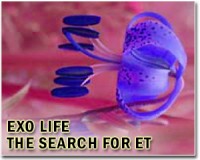 |
Tempe, Ariz. (UPI) Feb 28, 2011 A chemical examination of a meteorite found in Antarctica could lend weight to the argument life on Earth had extraterrestrial origins, U.S. researchers say. Researchers from Arizona State University and the University of California, Santa Cruz, say analysis shows the meteorite is rich in the gas ammonia, which contains the element nitrogen -- found in the amino and nucleic acids that form the basis of life, the BBC reported Monday. The scientists analyzed powder extracted from a meteorite called Grave Nunataks 95229, named after its place of discovery in Antarctica. The sample was found to contain abundant amounts of ammonia along with hydrocarbons, including the amino acids glycine and alanine. Analysis of the sample's isotopes of nitrogen and suggest the material originated from a "cold cosmic" environment, and were not the result of earthly contaminants, the researchers say. The study "shows that there are asteroids out there that when fragmented and become meteorites, could have showered the Earth with an attractive mix of components, including a large amount of ammonia," lead researcher Sandra Pizzarello of ASU said. Caroline Smith, a meteorite expert at London's Natural History Museum, agrees the important element in the new study is the nitrogen. "One of the problems with early biology on the early Earth is you need abundant nitrogen for all these prebiological processes to happen -- and of course nitrogen is in ammonia," she says. "A lot of the evidence shows that ammonia was not present in much abundance in the early Earth, so where did it come from?"
Share This Article With Planet Earth
Related Links Life Beyond Earth Lands Beyond Beyond - extra solar planets - news and science
 U.K. scientists to search for alien life
U.K. scientists to search for alien lifeLondon (UPI) Feb 28, 2011 British scientists say they will lead a $650 million program searching for chemical signs of life on planets orbiting distant stars. Researchers at University College London are at the head of the Exoplanet Characterization Observatory mission, backed by the European Space Agency, that will use a new space telescope to look for biomarkers in the atmospheres of exoplanets, The Independen ... read more |
|
| The content herein, unless otherwise known to be public domain, are Copyright 1995-2010 - SpaceDaily. AFP and UPI Wire Stories are copyright Agence France-Presse and United Press International. ESA Portal Reports are copyright European Space Agency. All NASA sourced material is public domain. Additional copyrights may apply in whole or part to other bona fide parties. Advertising does not imply endorsement,agreement or approval of any opinions, statements or information provided by SpaceDaily on any Web page published or hosted by SpaceDaily. Privacy Statement |